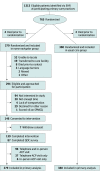Effectiveness of a Nurse-Led Multidisciplinary Intervention vs Usual Care on Advance Care Planning for Vulnerable Older Adults in an Accountable Care Organization: A Randomized Clinical Trial
- PMID: 33427851
- PMCID: PMC7802005
- DOI: 10.1001/jamainternmed.2020.5950
Effectiveness of a Nurse-Led Multidisciplinary Intervention vs Usual Care on Advance Care Planning for Vulnerable Older Adults in an Accountable Care Organization: A Randomized Clinical Trial
Abstract
Importance: Advance care planning (ACP), especially among vulnerable older adults, remains underused in primary care. Additionally, many ACP initiatives fail to integrate directly into the electronic health record (EHR), resulting in infrequent and disorganized documentation.
Objective: To determine whether a nurse navigator-led ACP pathway combined with a health care professional-facing EHR interface improves the occurrence of ACP discussions and their documentation within the EHR.
Design, setting, and participants: This was a randomized effectiveness trial using the Zelen design, in which patients are randomized prior to informed consent, with only those randomized to the intervention subsequently approached to provide informed consent. Randomization began November 1, 2018, and follow-up concluded November 1, 2019. The study population included patients 65 years or older with multimorbidity combined with either cognitive or physical impairments, and/or frailty, assessed from 8 primary care practices in North Carolina.
Interventions: Participants were randomized to either a nurse navigator-led ACP pathway (n = 379) or usual care (n = 380).
Main outcomes and measures: The primary outcome was documentation of a new ACP discussion within the EHR. Secondary outcomes included the usage of ACP billing codes, designation of a surrogate decision maker, and ACP legal form documentation. Exploratory outcomes included incident health care use.
Results: Among 759 randomized patients (mean age 77.7 years, 455 women [59.9%]), the nurse navigator-led ACP pathway resulted in a higher rate of ACP documentation (42.2% vs 3.7%, P < .001) as compared with usual care. The ACP billing codes were used more frequently for patients randomized to the nurse navigator-led ACP pathway (25.3% vs 1.3%, P < .001). Patients randomized to the nurse navigator-led ACP pathway more frequently designated a surrogate decision maker (64% vs 35%, P < .001) and completed ACP legal forms (24.3% vs 10.0%, P < .001). During follow-up, the incidence of emergency department visits and inpatient hospitalizations was similar between the randomized groups (hazard ratio, 1.17; 95% CI, 0.92-1.50).
Conclusions and relevance: A nurse navigator-led ACP pathway integrated with a health care professional-facing EHR interface increased the frequency of ACP discussions and their documentation. Additional research will be required to evaluate whether increased EHR documentation leads to improvements in goal-concordant care.
Trial registration: ClinicalTrials.gov Identifier: NCT03609658.
Conflict of interest statement
Figures
Comment in
-
Advance Care Planning and the Cost of Pragmatism.JAMA Intern Med. 2021 Mar 1;181(3):309-310. doi: 10.1001/jamainternmed.2020.5935. JAMA Intern Med. 2021. PMID: 33427866 No abstract available.
References
Publication types
MeSH terms
Associated data
Grants and funding
LinkOut - more resources
Full Text Sources
Other Literature Sources
Medical



